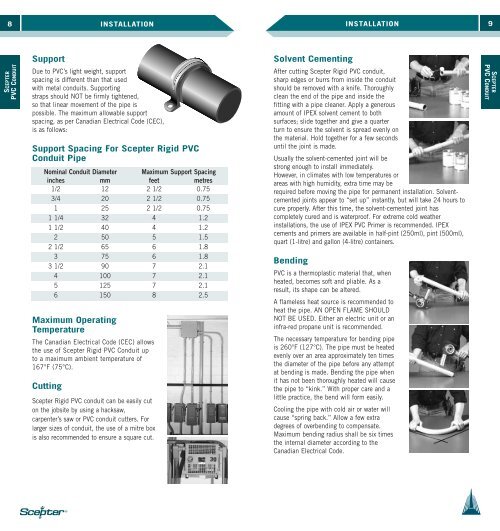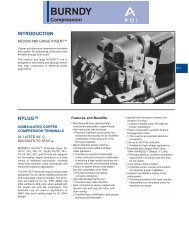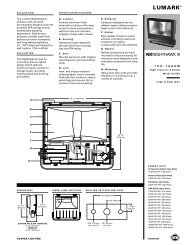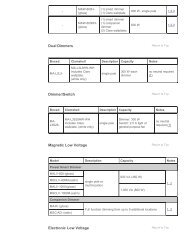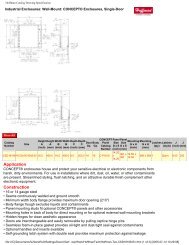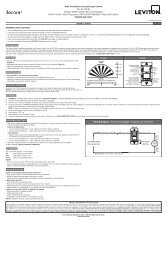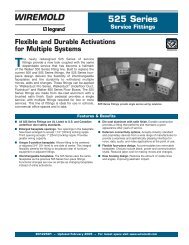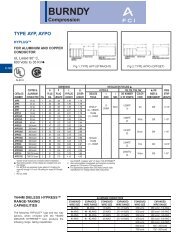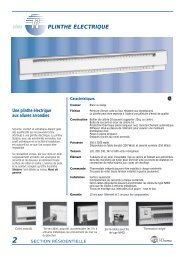Expansion Joint Reducer Coupling – Solvent Weld Split Wye - Nedco
Expansion Joint Reducer Coupling – Solvent Weld Split Wye - Nedco
Expansion Joint Reducer Coupling – Solvent Weld Split Wye - Nedco
You also want an ePaper? Increase the reach of your titles
YUMPU automatically turns print PDFs into web optimized ePapers that Google loves.
8 INSTALLATION<br />
INSTALLATION<br />
9<br />
SCEPTER<br />
PVC CONDUIT<br />
Support<br />
Due to PVC’s light weight, support<br />
spacing is different than that used<br />
with metal conduits. Supporting<br />
straps should NOT be firmly tightened,<br />
so that linear movement of the pipe is<br />
possible. The maximum allowable support<br />
spacing, as per Canadian Electrical Code (CEC),<br />
is as follows:<br />
Support Spacing For Scepter Rigid PVC<br />
Conduit Pipe<br />
Nominal Conduit Diameter Maximum Support Spacing<br />
inches mm feet metres<br />
1/2 12 2 1/2 0.75<br />
3/4 20 2 1/2 0.75<br />
1 25 2 1/2 0.75<br />
1 1/4 32 4 1.2<br />
1 1/2 40 4 1.2<br />
2 50 5 1.5<br />
2 1/2 65 6 1.8<br />
3 75 6 1.8<br />
3 1/2 90 7 2.1<br />
4 100 7 2.1<br />
5 125 7 2.1<br />
6 150 8 2.5<br />
Maximum Operating<br />
Temperature<br />
The Canadian Electrical Code (CEC) allows<br />
the use of Scepter Rigid PVC Conduit up<br />
to a maximum ambient temperature of<br />
167°F (75°C).<br />
Cutting<br />
Scepter Rigid PVC conduit can be easily cut<br />
on the jobsite by using a hacksaw,<br />
carpenter’s saw or PVC conduit cutters. For<br />
larger sizes of conduit, the use of a mitre box<br />
is also recommended to ensure a square cut.<br />
<strong>Solvent</strong> Cementing<br />
After cutting Scepter Rigid PVC conduit,<br />
sharp edges or burrs from inside the conduit<br />
should be removed with a knife. Thoroughly<br />
clean the end of the pipe and inside the<br />
fitting with a pipe cleaner. Apply a generous<br />
amount of IPEX solvent cement to both<br />
surfaces; slide together and give a quarter<br />
turn to ensure the solvent is spread evenly on<br />
the material. Hold together for a few seconds<br />
until the joint is made.<br />
Usually the solvent-cemented joint will be<br />
strong enough to install immediately.<br />
However, in climates with low temperatures or<br />
areas with high humidity, extra time may be<br />
required before moving the pipe for permanent installation. <strong>Solvent</strong>cemented<br />
joints appear to “set up” instantly, but will take 24 hours to<br />
cure properly. After this time, the solvent-cemented joint has<br />
completely cured and is waterproof. For extreme cold weather<br />
installations, the use of IPEX PVC Primer is recommended. IPEX<br />
cements and primers are available in half-pint (250ml), pint (500ml),<br />
quart (1-litre) and gallon (4-litre) containers.<br />
Bending<br />
PVC is a thermoplastic material that, when<br />
heated, becomes soft and pliable. As a<br />
result, its shape can be altered.<br />
A flameless heat source is recommended to<br />
heat the pipe. AN OPEN FLAME SHOULD<br />
NOT BE USED. Either an electric unit or an<br />
infra-red propane unit is recommended.<br />
The necessary temperature for bending pipe<br />
is 260°F (127°C). The pipe must be heated<br />
evenly over an area approximately ten times<br />
the diameter of the pipe before any attempt<br />
at bending is made. Bending the pipe when<br />
it has not been thoroughly heated will cause<br />
the pipe to “kink.” With proper care and a<br />
little practice, the bend will form easily.<br />
Cooling the pipe with cold air or water will<br />
cause “spring back.” Allow a few extra<br />
degrees of overbending to compensate.<br />
Maximum bending radius shall be six times<br />
the internal diameter according to the<br />
Canadian Electrical Code.<br />
SCEPTER<br />
PVC CONDUIT


